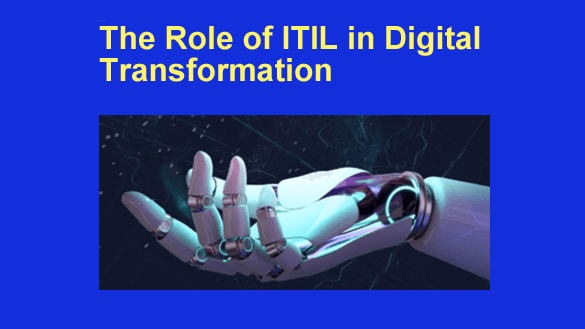 Knowing how to control IT services is like having a superpower in the fast-paced digital environment. Enter ITIL—short for Information Technology Infrastructure Library. But What is ITIL, and why is ITIL Certification the newest buzz?
Knowing how to control IT services is like having a superpower in the fast-paced digital environment. Enter ITIL—short for Information Technology Infrastructure Library. But What is ITIL, and why is ITIL Certification the newest buzz?
ITIL is a set of best practices that help companies make their IT services more efficient. We’ll explore in this blog how ITIL serves as a secret weapon for bringing IT services into line with corporate objectives, improving service delivery and increasing efficiency of operations.
Stick around to see how ITIL might turn your digital game around and propel your company towards unprecedented success.
Table of Contents
· Understanding ITIL: The Backbone of IT Services
· Digital Transformation: More than Just a Buzzword
· How ITIL Drives Digital Transformation
· The Practical Benefits of ITIL in Digital Transformation
· The Human Element: Change Management
· Conclusion: ITIL as a Catalyst for Digital Transformation
Understanding ITIL: The Backbone of IT Services
Imagine ITIL as the rulebook for IT services. It’s like the perfect manual for ensuring your IT staff is a well-oiled machine propelling your company forward rather than just a bunch of tech-savvy kids in a basement.
ITIL offers a coherent collection of best practices from the public and commercial sectors worldwide. Service Strategy, Service Design, Service Transition, Service Operation and Continuous Service Improvement are its five main stages.
Every stage of the service lifecycle has a particular purpose for assisting companies to control risk, improve customer interactions, create affordable policies, and create a reliable IT environment.
Digital Transformation: More than Just a Buzzword
Digital transformation goes beyond just moving data to the cloud or adopting the latest digital devices. It’s about reconsidering how you apply people, tools, and technologies to drastically raise company performance. It entails implementing fresh business concepts, enhancing consumer experiences, and fostering invention. This translates into a drastic change in perspective and culture for many companies.
How ITIL Drives Digital Transformation
Here’s where ITIL comes into play. It offers the structure required to properly oversee and assist efforts at digital transformation. Let’s analyze ITIL’s support of digital transformation:
Aligning IT with Business Goals
Aligning IT services with corporate goals is one of the fundamental ideas of ITIL. This guarantees that every IT project—from new software installations to IT support—directly advances the general corporate agenda. By helping companies to grasp their business objectives and create IT solutions that complement them, ITIL guarantees that efforts at digital transformation are deliberate and in line with the vision of the firm.
Enhancing Service Delivery
The emphasis of ITIL on service design and delivery guarantees that new digital services are developed considering the end-user. In digital transformation, when the goal is usually to enhance customer experiences, this user-centric approach is vital. Following ITIL helps companies guarantee that their digital services are dependable, effective, and user-friendly, thus improving customer happiness and loyalty.
The Practical Benefits of ITIL in Digital Transformation
Improved Efficiency and Productivity
ITIL helps companies lower waste and increase efficiency by standardizing procedures and building consistent workflows. This is essential in the context of digital transformation, where faster time-to-market for new digital initiatives can be driven by simplified operations, significantly improving productivity.
Better Risk Management
Digital transformation sometimes entails some risk, especially when using new technologies. Strong risk management techniques included in ITIL’s all-encompassing framework enable companies to find, evaluate, and reduce digital transformation project risks. This proactive risk management strategy resolves possible problems before they become serious ones.
Cost Management
Cost control presents one of the toughest obstacles in digital transformation. By encouraging cost-effective methods and effective resource use, ITIL helps companies control expenses. ITIL also helps companies eliminate wasteful expenses and maximize IT operations, freeing more resources for innovation and expansion.
The Human Element: Change Management
Digital transformation involves people as much as technology. From senior management to front line workers, all stakeholders must be involved for a successful digital transformation. Here, especially, ITIL’s change management techniques are vital. They guarantee that staff members are well-prepared, informed, and supported throughout the transformation process, therefore helping companies control the human aspect of change.
Conclusion: ITIL as a Catalyst for Digital Transformation
In a world where digital transformation is now a need rather than a want, ITIL offers the methodical methodology required to negotiate this convoluted path. It guarantees effective, risk-regulated operations, improves service delivery, and helps IT to match corporate goals.
Whether you are a global enterprise or a giant in financial services, ITIL may drive your attempts at digital transformation to unprecedented levels. Therefore, if you want to digitize your company, don’t undervalue the influence of ITIL; it might just be the transformation you require.
Enhance ITIL skills with The Knowledge Academy courses.